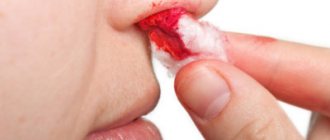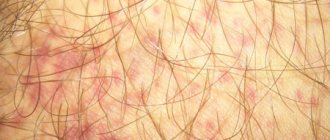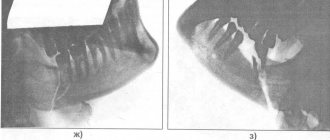Any injury is usually accompanied by bleeding. In this case, severe blood loss often poses a greater danger to the life of the victim than the injury itself.
There are several ways to stop bleeding, each of which is used in a specific situation. A tourniquet is used in exceptional cases when a large artery is damaged or other methods to stop blood loss were not effective.
With severe blood loss, there is no time to think, so it is important to clearly know how to apply a tourniquet correctly, because the slightest mistake will threaten the victim with amputation due to tissue death.
Considering that, depending on the type of bleeding, there are 2 methods of using a tourniquet, it is necessary to clearly distinguish between the types of blood loss.
Features of using a tourniquet
Capillary blood loss does not pose a threat to human life and is characterized by minor and slow bleeding. To stop the bleeding, it is enough to treat the wound with antiseptic agents.
With venous bleeding, the blood is dark in color and flows out of the wound in a continuous stream. Most often, a compressive bandage or tampon is used to stop blood loss. A tourniquet is applied only as a last resort.
When bleeding from damaged arteries, the blood flows out in spurts and has a bright scarlet color. Such blood loss poses a serious danger to the life of the victim. With it, a tourniquet is almost always applied.
We list the moments when a tourniquet should be applied to stop blood loss:
- When the bleeding is so severe that stopping it by other methods is not possible;
- When a rupture of an arm or leg is recorded;
- If there is a foreign object in the wound that does not allow the blood to stop;
- If a large amount of blood loss has already been recorded, and there is little time to save the person.
In what situations is it strictly prohibited to use a tourniquet:
- Bleeding from capillaries;
- Obvious inflammatory processes in the wound;
- Open fractures of bones or joints;
- It is forbidden to use a tourniquet on the lower thigh or shoulder, as this will damage a large number of nerve endings.
It is also important to know a few rules on how to apply a tourniquet so that the tissue does not become dead:
- If there is no medical device at hand, you can use any wide fabric instead of a tourniquet. The main condition for this is that it should not be narrower than 4 cm. This means that objects such as wires or ropes cannot be used instead of a tourniquet: they will cut into the skin.
- The bandage is not applied to the damaged area of the body, but to a place located 5 cm above it.
- Only a medical professional can remove the device, otherwise there is a high risk of developing infectious complications.
- After applying the tourniquet, attach a note to it indicating the exact time. The patient’s condition after its removal depends on how long the hemostatic bandage is applied.
Overlay errors and their consequences
When providing emergency assistance, it is necessary to take into account the correct application of the tourniquet. In the opposite situation, adverse complications may occur.
Main errors of the technique:
- the tourniquet is applied without strict reasons;
- tying a tourniquet on the skin not covered with fabric, causing trophic changes in the integument;
- using the technique on the shins or forearms (not allowed due to the presence of two adjacent bones);
- insufficient tightening force, which does not stop blood loss;
- violation of deadlines for any method of applying a tourniquet.
The tourniquet procedure is a major component of the bleeding management process. However, the manipulation must be carried out in accordance with all rules and standards in order to avoid worsening the victim’s condition.
Tactics for arterial bleeding
Injuries in which blood spurts out of the arteries are dangerous due to large and rapid blood loss, so it is important to know how to apply a tourniquet in case of arterial bleeding.
Before applying the device, you need to prepare all the materials needed for this:
- A harness or material replacing it;
- A small, strong tube or stick;
- Bandage or any clean cloth;
- Roller from the first aid kit or made yourself.
When all the necessary devices are at hand, the artery from which the blood comes is firmly clamped with a finger or fist.
Next, you need to choose the method of applying the device (it depends on the location of the injury) and start using it.
We list the methods for applying a tourniquet for arterial bleeding, depending on the location of the wound.
If the carotid artery is damaged, the first aid provider should apply a tourniquet to the neck. This procedure is as scary as it is necessary, since blood leaves the artery very quickly, which without urgent measures will lead to the death of a person.
Considering that there will be a lot of blood, it will not be possible to pinch the artery with your finger: it will slide. Therefore, in this case, you need to squeeze it with a piece of cloth, and if it is missing, you can use part of the victim’s clothing.
Next you need to act in the following sequence:
- A cloth or gauze roller is placed on the material with which the artery is being compressed;
- A tourniquet is applied to it so that on the opposite side of the wound it is pulled over the victim’s arm, which is raised up and thrown behind his head.
If the hip is injured, a tourniquet is applied as follows:
- Raise the affected limb higher;
- Clamp the artery;
- Make a tourniquet from two scarf-type bandages;
- Wrap the bandage around your thigh and tie a strong knot;
- Be sure to place a fabric roller or a small gauze bandage under it;
- Carefully pass a stick or tube under the knot;
- Lift the device and slowly rotate it until it touches the injured leg;
- After the blood loss has stopped, press the stick, securing the tourniquet with its second part.
For injuries of the upper extremities, use a tourniquet applied to the shoulder.
The algorithm of actions in this case should be as follows:
- Raise your injured arm up;
- Apply pressure to the pulsating artery;
- Fold the tourniquet like a loop (in half);
- Throw the loop over your shoulder;
- After the tourniquet is thrown over the shoulder, pull on its ends until the blood stops flowing;
- Tie the ends of the tourniquet in a knot.
Signs of bleeding
Bleeding, in addition to the described external signs, also has general symptoms associated with blood loss:
- pale skin;
- dizziness, ringing in the ears;
- decreased blood pressure;
- increased heart rate - tachycardia;
- cold clammy sweat;
- fainting state.
With severe blood loss, for example, from the carotid artery, symptoms increase quickly and hemorrhagic shock develops: severe lethargy, low blood pressure, weak pulse.
Loss of 2 liters of blood or more if assistance is not provided in a timely manner can be fatal.
Tactics for venous bleeding
With venous bleeding, blood loss occurs a little more slowly, but there is a high risk of air getting into large veins. When a vein is damaged, the air that has entered it is converted into small bubbles that quickly move towards the heart or brain. If they reach one of these organs, an embolism (blockage of blood vessels) will occur, which in most cases leads to the death of the patient.
If blood loss from a vein is detected, you need to proceed according to the following scheme:
- Treat the wound with disinfectants;
- Shape the gauze or bandage into a tampon by rolling it in several layers;
- Place a clean cloth on top of the tampon, securing it with a wide bandage so that it is not on the damaged area, but around it;
- Make sure the bandage is applied tightly enough. Then it will help connect the torn edges of the vein.
- Most often, such methods are effective and quickly eliminate bleeding. However, if a deep vein is ruptured, the above measures do not produce results: rapid blood loss continues. Only in this case, in case of venous bleeding, use a tourniquet!
- If during arterial bleeding a tourniquet is used above the site of injury, then venous injuries require the opposite location: under the wound. This feature is associated with the functional responsibilities of the veins, because the blood in them moves from bottom to top, that is, directly to the muscles of the heart, and not from them.
- When using this device, it is important to remember that applying it to unprotected skin is unacceptable! Any material can be used. If there is not a single piece of clean fabric, you can use elements of the victim’s clothing for these purposes.
Algorithm for using a tourniquet for bleeding from a vein:
- Without pulling, bandage the limb loosely with the device;
- Slide a tube or stick under it;
- Taking both ends of the tube, begin to twist the tourniquet until you achieve optimal compression.
Important information
We have already mentioned that a tourniquet is used only in exceptional cases, since its incorrect use will cause irreparable harm to the patient. Therefore, it is important to be able to determine that the hemostatic tourniquet is applied correctly.
If the device is applied correctly, the following factors are noted:
- Blood loss stops;
- The skin becomes pale in the place where the tourniquet is located and above;
- There is a clear pulsation in the area below the blocked artery.
- If there is no pulsation, this indicates excessive compression of the artery. In this case, the device should be relaxed.
- No less important is the factor for how long the tourniquet is applied: prolonged occlusion of arteries or veins leads to complete tissue necrosis. That is why an important condition after the event is to write a note indicating the time when the device was secured. In the event that there is no paper and pen to make the necessary notes, the time is written in the patient's blood on his face or limb. This indication will be the deciding factor for medical personnel for further emergency action.
- The critical maximum for a tourniquet to be on the human body is half an hour in winter and an hour in the hot season. If medical help does not arrive during this time, the tourniquet is loosened or removed by squeezing the artery with a finger.
- The next bandage is applied no earlier than 15 minutes after the previous one. At the same time, the time of its use should also not be more than 15 minutes.
Correct use of a tourniquet is sometimes the only way to save a human life. Therefore, in such an emergency situation, you need to act without panic and quickly, following the order of the above actions.
Types of bleeding
To effectively help with bleeding, you need to have an idea of its nature. It is not difficult to determine the type of bleeding; there are 3 types:
- arterial;
- venous;
- capillary.
Arterial bleeding
Arteries are vessels that carry blood from the heart to the periphery, to all organs and tissues. The blood enters them in impulses as a result of the contraction of the heart - systole, in addition, it has passed through the pulmonary circle and is enriched with oxygen. Accordingly, if the artery is damaged, it will have the following characteristics: it exits as a pulsating stream, in accordance with the rhythm of the heartbeat, and is bright scarlet in color.
Venous bleeding
Through the veins to the heart in the opposite direction, “waste” blood flows from organs and tissues, which has given up oxygen and is saturated with carbon dioxide. It occurs as a result of the attractive force of the heart during relaxation of the heart muscle (diastole). Therefore, if a vein is damaged, it will flow out in a uniform stream and have a dark color.
Capillary bleeding
Capillaries are multiple tiny ends of blood vessels located in the skin, through which tissue cells receive oxygen from arterial blood. Damage to capillaries occurs due to superficial injuries: abrasions, scalp wounds. Blood in such injuries has a bright scarlet color and is released gradually and evenly over the entire surface of the wound, as if seeping, without pulsation.
The first 2 types of bleeding can be stopped by applying a tourniquet, but with capillary bleeding it is contraindicated and makes no sense. It is enough to apply a pressure bandage and cold to the wound area.
When to apply a tourniquet
To stop venous bleeding, in most cases, applying a pressure bandage using a roller is sufficient. If possible, a ligature is tied to the bleeding vessel or a hemostatic clamp is applied. An arterial tourniquet is applied when large arteries of the extremities (arms and legs) are damaged. In order to stop bleeding, the vessel is first pressed with a finger or fist to gain time. They choose a method to stop the bleeding, prepare the necessary materials, and only then apply a tourniquet.
How to apply a tourniquet correctly
A hemostatic tourniquet is applied above the bleeding site, as close to the wound as possible, but without touching the damaged skin. Places for dragging a limb:
- Mid-calf.
- Middle third of the thigh.
- Lower third of the forearm.
- Upper third of the shoulder.
- The root of the limb with fixation to the body.
A bandage or piece of cloth is placed under the tourniquet to avoid damage to soft tissues. The rubber is stretched and the first turn is applied. It should stop the bleeding completely. Next, the tension of the tourniquet is released, making several turns until the tourniquet can be fixed. If the tension of all the turns is strong, this will lead to injury to the soft tissues. If weak, the tourniquet will cause venous stagnation without stopping the bleeding. The limb will take on a bluish tint.
When a tourniquet is applied correctly, the limb turns pale, the pulse below the compression site cannot be felt, and the bleeding stops immediately.
Applying a tourniquet for bleeding can be done in different ways, depending on the location of the vessel damage.
- Gersh-Zhorov technique. The tourniquet is applied using a counter-support pad, while maintaining collateral circulation. On the side opposite to the location of the damaged artery, a wooden splint or piece of plywood is placed under the tourniquet. In this case, circular compression does not occur completely; the blood supply to the limb below the tourniquet is partially preserved. Application time increases. This method is also used when reapplying a tourniquet after it has been loosened, during long-term transportation of the victim.
- A figure-of-eight tourniquet is used if necessary to stop bleeding in the upper limb. With this method, the tourniquet does not slide down. If there is bleeding on the shoulder, the tourniquet is applied to the armpit, wound around the body, crossed over the shoulder girdle and fixed in the armpit of the opposite side. To compress the femoral artery, use a dense roller, fixed with a tourniquet in the area of the pubic bone. The tourniquet is drawn in a figure eight around the body.
- In case of bleeding from the carotid artery, the roller is pressed with a tourniquet secured to the neck using a counter support made of a wooden splint applied on the opposite side. Do not over-tighten the tourniquet. The blood supply to the head is carried out through the carotid artery, protected from compression by a splint. For the same purpose, it is possible to bandage a thick roller to the artery; the opposite hand raised upward is used as a counter support.
In any case, after applying a tourniquet, the limb is immobilized. A note is placed under the tourniquet indicating the time of application.
Stages of applying a tourniquet
When providing first aid for major arterial bleeding on the extremities, it is necessary to strictly follow the rules for applying a tourniquet. In the absence of a specialized device (a self-tightening strip with holes for fixation), you can use improvised means (a belt, a bandage folded in several layers, a rubber tube or rope).
The rules for applying a tourniquet are an algorithm of sequential actions:
- Apply a bandage to the exposed limb (from 5 to 7 cm above the upper edge of the wound) or wrap it in a terry towel, eliminating any bumps or bumps.
- Above the bleeding area, wrap the limb with a tourniquet several times and secure it (if the tourniquet is applied tightly enough, the bleeding stops).
- The time for applying a tourniquet is determined by the season: in winter it should not exceed 90 minutes, in summer – two hours.
In cold weather, the injured limb should be isolated from low temperatures if possible. After providing assistance, the tourniquet should be loosened for 5-10 minutes, and the wound should be pressed firmly with your hand through the bandage. The tourniquet should be loosened an hour after its application, and then every hour.
What improvised means can be used instead of a tourniquet?
In the event that you do not have a compressive tourniquet at hand, you can use the following means:
- A piece of fabric and a stick (pen, pencil, ruler, toothbrush) - form a circle from a piece of fabric. A limb is placed in the lower part of the circle, and a twist loop is made in the upper part, into which a stick is inserted. Gradually begin to twist clockwise, controlling the compression force.
- Belt or elastic belt - these products are tightly fixed to the body and do not require additional control.
- Any ropes that have a rubberized base - they are tightened in the same way as a tourniquet, pre-lining them with fabric to avoid necrotic damage to the skin.
If you don’t have a tourniquet at hand, use a piece of fabric and a stick.
In the process of searching for a suitable object that can perform the functions of a tourniquet, you should press the vessel above the wound site, which will reduce blood loss.
general characteristics
A tourniquet is a device to stop bleeding. It is used to compress the soft tissues of the affected limbs in order to temporarily stop blood loss and have time to deliver the victim to a doctor. A bandage is necessary to stop extensive bleeding from the great vessels. In other cases, compression and a tight bandage are sufficient.
Ideally, the tourniquet is applied for a maximum of 30-40 minutes, regardless of the person’s condition, time of year, environmental conditions and other factors. Why? In essence, the limb is “cut off” from the general blood flow, which can be fraught with tissue necrosis, infringement of the organ’s nerve trunks, and even death. Oxygen starvation develops in a separate part of the body. The tissue stops receiving vital components such as blood, oxygen and nutrients. The result is limb death and the need for amputation.
What to do if you can’t get a tourniquet in an emergency? Make a makeshift bleeding stop using fabric tape, rope, your own belt, and anything else you can get your hands on. They will help stop blood loss and fix the affected area no worse than medical instruments. The main difference is the comfort of the first aider. Most rubber bands have holes made for a retainer or are self-tightening. This simplifies the provision of emergency first aid, but even an ordinary piece of fabric, hastily torn from clothing, will perform an identical function (if used correctly).











